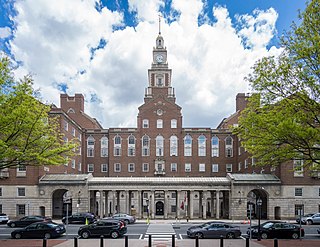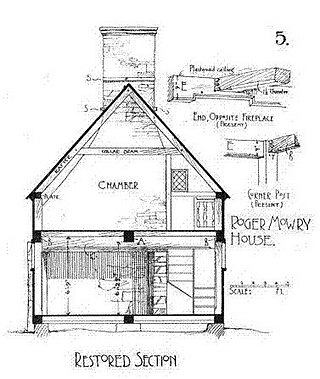

The stone-ender is a unique style of Rhode Island architecture that developed in the 17th century where one wall in a house is made up of a large stone chimney.


The stone-ender is a unique style of Rhode Island architecture that developed in the 17th century where one wall in a house is made up of a large stone chimney.
Rhode Island was first settled in 1636 by Roger Williams and other colonists from England. Many of the colonists came from western England and brought the prevalent British architectural ideas with them to New England, but adapted these to the environment of Rhode Island. The colonists built “stone enders” which made use of the material that was in abundance in the area: timber and stone. Rhode Island also had an abundance of limestone (in contrast to the other New England states), and this allowed Rhode Islanders to make mortar to build massive end chimneys on their houses. Much of the lime was quarried at Limerock in Lincoln, Rhode Island.
Only a few stone enders remain in the 21st century. Architectural restoration specialist Norman Isham restored several original stone enders in the early 20th century (see Clement Weaver House and Clemence-Irons House). Scituate sculptor Armand LaMontagne hand-built a large 17th-century style stone-ender off of Route 6 in Scituate, Rhode Island in the 1970s.
Stone ender houses were usually timber-framed, one and one-half or two stories in height, with one room on each floor. One end of the house contained a massive stone chimney which usually filled the entire end wall, thus giving the dwelling the name of “stone ender.” Robert O. Jones noted that the windows were very small “casements filled with oiled paper” and that “the stairs to the upper chambers were steep, ladder-like structures usually squeezed in between the chimney and the front entrance.” [1] He points out that a few houses may have had leaded glass windows, but that was very rare. See Clement Weaver House, East Greenwich, Rhode Island for an example containing the leaded glass windows and ladder-like stairs.

Providence County is the most populous county in the U.S. state of Rhode Island. As of the 2020 census, the county's population was 660,741, or 60.2% of the state's population. Providence County contains the city of Providence, the state capital of Rhode Island and the county's most populous city, with an estimated 190,934 residents in 2020. Providence County is included in the Providence-Warwick, RI-MA Metropolitan Statistical Area, which in turn constitutes a portion of the greater Boston-Worcester-Providence, MA-RI-NH-CT Combined Statistical Area. As of 2010, the center of population in Rhode Island is located in Providence County, in the city of Cranston.

Johnston is a town in Providence County, Rhode Island, United States. The population was 29,568 at the 2020 census. Johnston is the site of the Clemence Irons House (1691), a stone-ender museum, and the only landfill in Rhode Island. Incorporated on March 6, 1759, Johnston was named for the colonial attorney general, Augustus Johnston.

Route 126 is a 14.3-mile-long (23.0 km) state highway in the U.S. state of Rhode Island. Route 126 is a heavily traveled route in Pawtucket. Its southern terminus is at U.S. Route 1 in Providence, and its northern terminus is at the Massachusetts border where it continues as Massachusetts Route 126.

The Episcopal Diocese of Rhode Island is a diocese of the Episcopal Church in the United States of America, encompassing the state of Rhode Island. It is one of seven New England dioceses that make up Province 1.

Benedict Arnold was president and then governor of the Colony of Rhode Island and Providence Plantations, serving for a total of 11 years in these roles. He was born and raised in the town of Ilchester, Somerset, England, likely attending school in Limington nearby. In 1635 at age 19, he accompanied his parents, siblings, and other family members on a voyage from England to New England where they first settled in Hingham in the Massachusetts Bay Colony. In less than a year, they moved to Providence Plantation at the head of the Narragansett Bay at the request of Roger Williams. In about 1638, they moved once again about five miles (8 km) south to the Pawtuxet River, settling on the north side at a place commonly called Pawtuxet. Here they had serious disputes with their neighbors, particularly Samuel Gorton, and they put themselves and their lands under the jurisdiction of Massachusetts, a situation which lasted for 16 years.

The Eleazer Arnold House is a historic house built for Eleazer Arnold in about 1693, and located in the Great Road Historic District at Lincoln, Rhode Island. It is now a National Historic Landmark owned by Historic New England, and open to the public on weekends.

The Clemence–Irons House is a historic house located in Johnston, Rhode Island. It was built by Richard Clemence in 1691 and is a rare surviving example of a "stone ender", a building type first developed in the western part of England and common in colonial Rhode Island. The house is listed on the National Register of Historic Places, and is a historic house museum owned and operated by Historic New England. It is open Saturdays between June and mid-October.

Norman Morrison Isham (1864–1943) was a prominent architectural historian, author, and professor at Brown University and Rhode Island School of Design (RISD). He was an ardent preservationist and a pioneer in the study of early American architecture.

The Clement Weaver–Daniel Howland House is a historic stone-ender timber frame house built in 1679. This rare example of primitive 17th-century architecture is located at 125 Howland Road in East Greenwich, Rhode Island. It is the oldest documented dwelling house in Kent County and the second oldest home in Rhode Island.

The Thomas Fenner House or the "Sam Joy Place" is a historic stone-ender house in Cranston, Rhode Island. It the oldest surviving house in the Providence Plantations portion of Rhode Island. The only older structure in the state is the White Horse Tavern in Newport. The house was built as a farmhouse in 1677 after King Philip's War by Captain Arthur Fenner for his son Major Thomas Fenner. The house was added to the National Register of Historic Places in 1990. The House is available for short stays by those interested in the historical and architectural significance of the property. It also is made available to educational groups to visit and study.

The 2012 United States House of Representatives elections in Rhode Island were held on Tuesday, November 6, 2012 to elect the two U.S. representatives from the state of Rhode Island, apportioned according to the 2010 United States census. The elections coincided with the elections of other federal and state offices, including a quadrennial presidential election and an election to the U.S. Senate. Primary elections were held on September 11, 2012.

William R. Walker & Son was an American architectural firm in Providence, Rhode Island, active during the years 1881 to 1936. It included partners William Russell Walker (1830–1905), William Howard Walker (1856–1922) and later William Russell Walker II (1884–1936).

Robert Charles Nicholson Monahan was a Canadian-American architect from Pawtucket, Rhode Island.

The Church of Jesus Christ of Latter-day Saints in Rhode Island refers to the Church of Jesus Christ of Latter-day Saints and its members in Rhode Island.